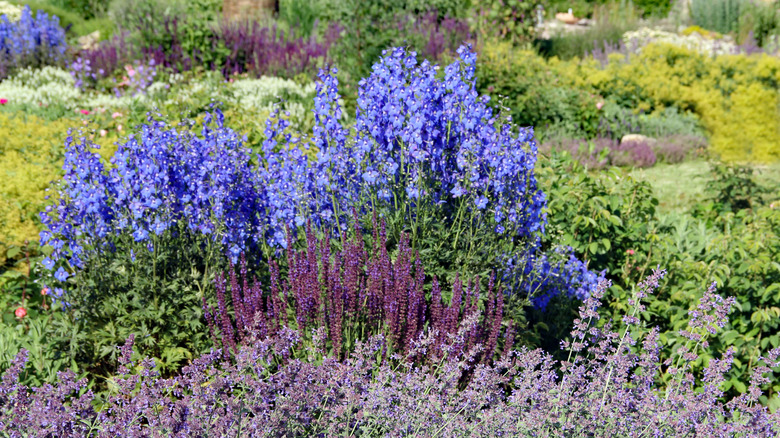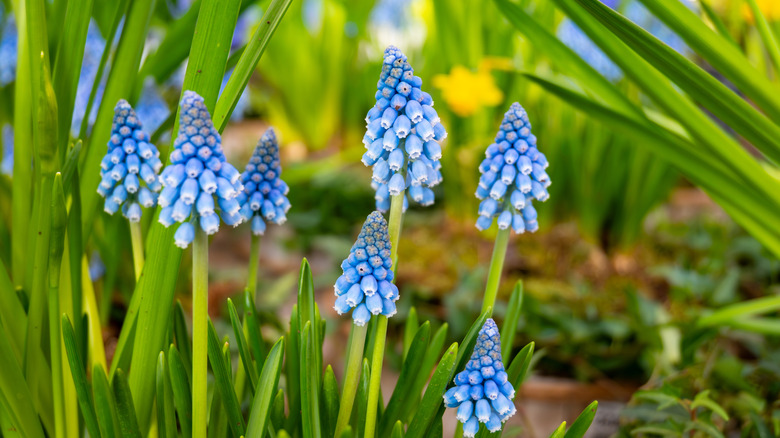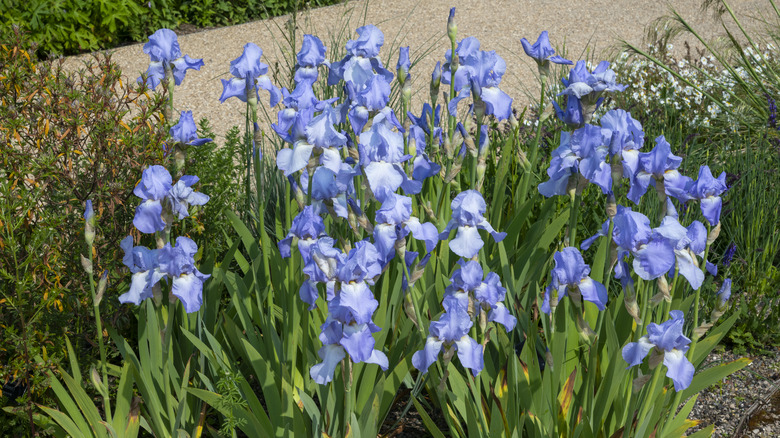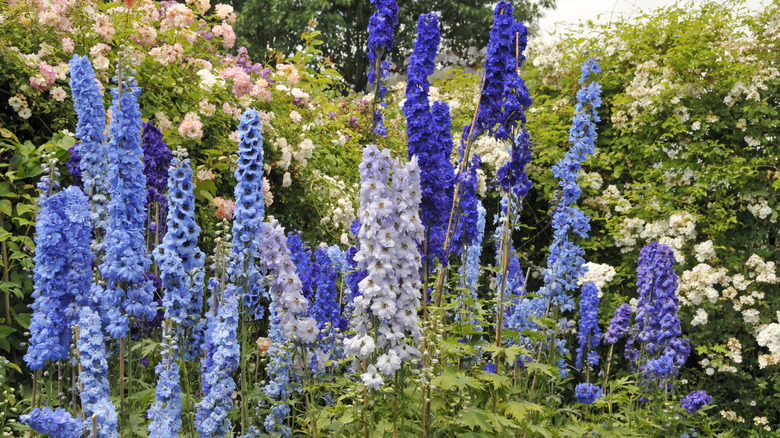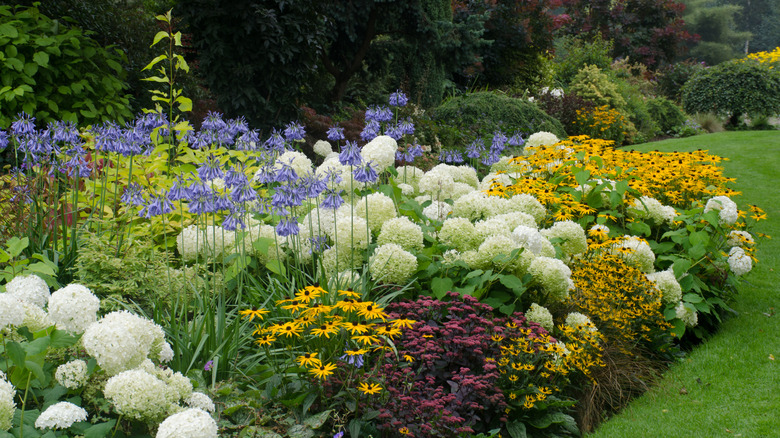Blue Is A Beautiful Color To Have In The Garden. Here's How To Do It Right
Most gardeners have some favorite flower colors they gravitate towards. Some like pink, some like red, and others like white or yellow. Blue is often a favorite color, partly because it seems to be somewhat elusive in nature, and most flowers described as "blue" are a bit closer to purple or violet. But not only are there many stunning blue flowers you can grow in your garden, there are also some tricks to making blue hues really stand out.
One way to show off blue flowers is to experiment with different color palettes to enhance them. This can be done with flowers of various colors or with different hues of foliage. Imagine, for example, a garden palette of blue flowers from pale periwinkle to midnight navy alongside plants with blue-green foliage like hostas (try 'Halcyon,' 'Abiqua Drinking Gourd,' or 'Canadian Blue'), junipers, sedums ('Sieboldi' or 'Mojave Jewels Sapphire'), and ornamental blue grasses like blue fescue grass. Or you could try a more adventurous color palette, like blue flowers paired with magenta blooms and plants with silvery or yellow-green foliage.
You can also use blue objects to bring out blue flower colors, like furniture, planters, or decorative pieces. Try painting your fence blue or adding some blue cushions to your patio furniture to enhance the blues in your garden. Glazed blue ceramic pots are a great choice for arrangements of container annuals. Some great annuals for adding blue to containers include the versatile, long-blooming, low-growing lobelia, in shades of pale pastel blue to deep sapphire, and the fuzzy little buttons of 'Blue Mink' dwarf ageratum.
Start with blue flowering spring bulbs
There are quite a few different blue-flowering spring bulbs, and these will add gorgeous blue color right at the start of the season. Many of these flowers are fairly small or low-growing, so give them a good spot at the front of the border or along paths for maximum visibility. There's also a great range of blue hues, from the delicate pale blues of 'Blue Pearl' crocus and early stardrift, also known as striped squill, to sky-blue Siberian squill, to the periwinkle blues of Balkan anemones and Glory of the Snow.
Some bulbs have an array of blues that allow you to have a stand of the same plants in various blue shades. This can be a really striking effect in the spring garden. Try this with early dwarf irises like sky blue 'Katharine Hodgkin' and cobalt blue 'Alida,' Dutch hyacinths like the porcelain blue 'Blue Jacket,' the pale violet blue 'Delft Blue,' and the gorgeous deep blue 'Royal Navy.' Consider grape hyacinths like 'Dark Eyes' in cobalt with white edges or 'Peppermint' in pale periwinkle blue.
Some late spring flowering bulbs that come in shades of blue include camassia (try pale 'Blue Danube' or blue-violet 'Blue Melody'), ipheion (try the 'Constellation of Blue Stars' mix of blues with white), and alliums (like the sky blue 'Azureum'). For partial shade spots, plant Spanish bluebells or English bluebells. Place an assortment of these spring bloomers strategically throughout your garden to have a delightful show of blue from March through May.
Plant blue flowering perennials for large drifts of color
Planting perennials in large drifts lets you have vivid swathes of color in the garden as the season progresses. In mid-spring, after bulbs begin to fade, next come powder blue forget-me-nots and pale blue woodland phlox. Then comes amsonia, which has a shrub-like form that dies back every fall but pops up slender stems covered with pale blue starlike flowers in late spring. German bearded irises offer many blues for mid- to late spring color: try 'Raindance Returns' (pale blue dwarf rebloomer), 'Best Bet' (two-tone violet-blue), or 'Blueberry Bliss' (vivid deep blue).
Summer is a grand time for cooling blue in the garden. In early summer, the perennial geraniums flower and continue through fall. Midsummer brings clematis flowers, which come in a range of blues, and the violet blues of false indigo. Midsummer's show also includes tall, delicate flowers like delphiniums and agapanthus, plus the intriguing pale blue flowers of sea holly and globe thistle. Blue cornflowers are one of the truest blue flowers and can be grown easily from seed.
Late summer brings more dramatic blue blooms that stretch into autumn: spikes of deep navy blue monkshood burst into bloom, blue asters from tall to small start their long-running show, and fluffy blue mistflower, also known as perennial ageratum, blooms for weeks. Don't forget blue-flowering shrubs that flower from late summer through autumn, like broadleaf hydrangeas (try 'Nikko Blue,' 'Blue Enchantress,' or 'Blue Jangles'), blue mist spirea, or rose of Sharon, which has several varieties with periwinkle blue flowers.
Blue cottage garden favorites add texture and form
Though cottage gardens are often eclectic and varied in style, and there are no hard and fast rules, most gardeners would probably agree that designing and planting the perfect cottage garden means planning for three seasons of blooms and plenty of textures, shapes, and colors to delight the eye. You can also add a touch of romance with soft pastel colors and fluffy blooms.
Delphiniums are a great cottage garden flower: their fluffy flower spikes provide plenty of color for weeks, and the range of blues is extraordinary, from pale pastel to deep midnight blue. They also add vertical interest for a dynamic design. Another spiky blue stunner is Salvia. There are many blue perennial salvias, like the light cerulean 'Crystal Blue,' or salvias for warmer zones, like dark blue 'Victoria.' Then there are speedwells, with long wand-like flowers in a range of colors, including some vivid blues such as 'First Glory' and 'Blue Skywalker.'
Some other flowers that offer blue shades in soft textures include flowering catmint — the bluest ones include 'Walker's Low,' 'Cat's Pajamas,' and 'Purrsian Blue.' Russian sage has long, delicate-looking sprays of lavender blue flowers: try 'Blue Jean Baby' or 'Denim 'n Lace.' All of these fragrant cottage garden favorites are also deer resistant and attract many pollinators to your garden.
Winning color combinations with blue
Many gardeners agree that planting blue flowers with white flowers creates a feeling of peace and tranquility. Also, white flowers make a wonderful accent to blue flowers, creating an overall cool palette that blends well with all shades of green. But you can experiment with other colors — blues and pinks can look very vibrant together, especially in unexpected combinations that play with contrast, like pastel pink with dark blue or hot pink with pale blue.
Blue and orange are opposites on the color wheel, so orange, as well as yellow-orange or red-orange, are excellent companions for blue flowers, as their opposing hues really "pop" when they're in close proximity. Also, adding blue flowers is a great way to cool down the brightness of a garden with a warm color palette of reds, yellows, and oranges.
Another way to make the most of blue in the garden is to pair it with analogous colors that enhance it and bring out blue tones. Planting a violet-blue flower like delphinium next to flowers in shades of plum (like salvia) and lavender (like catmint) will tend to emphasize the delphinium's blue tones and make them seem more vivid. This could also be achieved by pairing blue blooms with blue-green foliage plants like spruce or juniper. Another analogous color to blue is green: yellow-green tones can really enhance blue flowers. Try lady's mantle, which has chartreuse flowers, or a vivid yellow-green heuchera like 'Citronelle,' or, as a great annual choice, a lime green coleus like 'Colorblaze Lime Time.'
